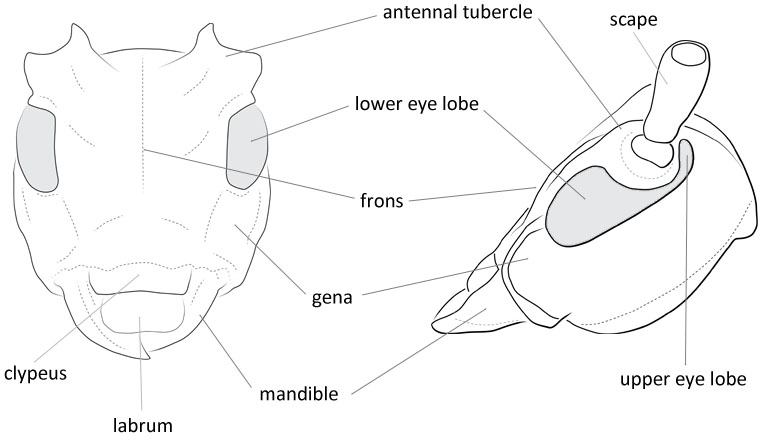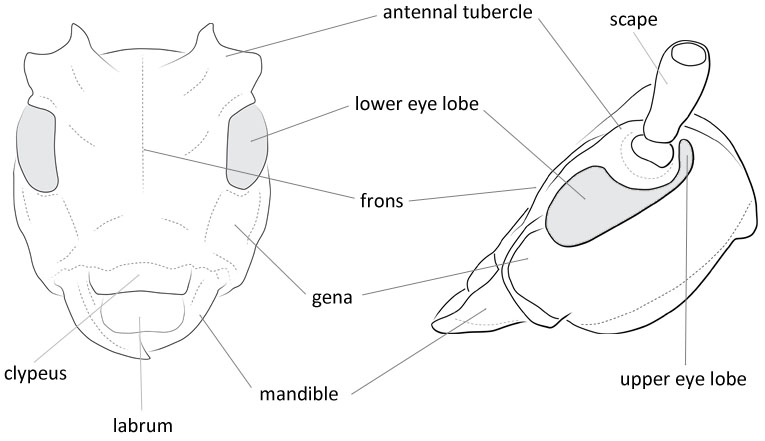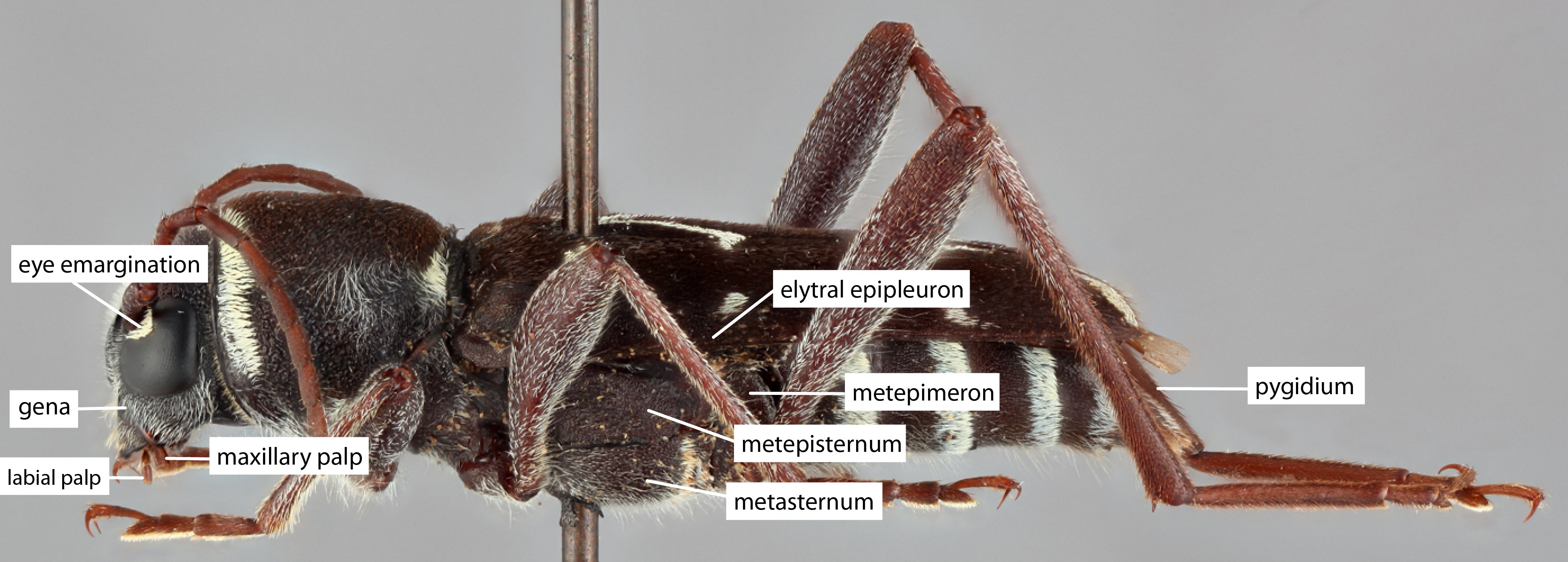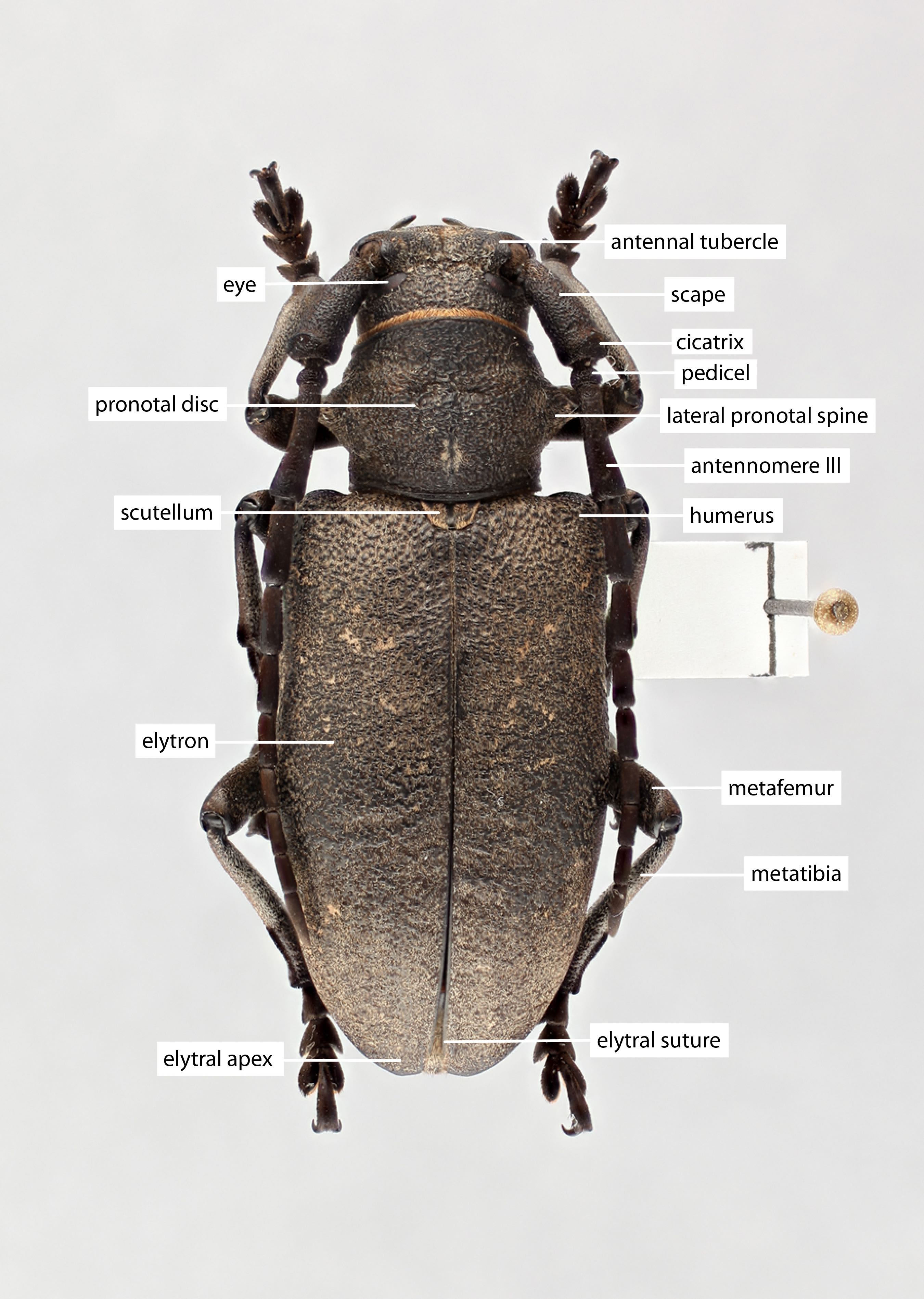Cerambyx galloprovincialis Olivier, 1795: 125
Length: 11.5–27 mm.
Elytral length:width ratio: length > 2x width.
Face: shape wide rectangle; genagena:
the part of the cranium on each side below the eye length shorter than lower eye lobeeye lobe:
length shorter than lower eye lobeeye lobe:
used to refer to the upper or lower portion when the eye is emarginate or separated or subequal to lower eye lobeeye lobe:
or subequal to lower eye lobeeye lobe:
used to refer to the upper or lower portion when the eye is emarginate or separated .
.
Pronotum: dense setaeseta:
a sclerotized hair-like projection of the cuticle
on dorsum of lateral spines present; maculaemacula:
a spot or mark
on pronotal disk absent; posteromedial tubercletubercle:
a small knoblike or rounded protuberance
absent; lateral erect setaeseta:
a sclerotized hair-like projection of the cuticle
: only present posterior to spinespine:
a protuberance with an acute (sharp) distal end
.
Scutellum: pubescence broken at least partially along midline.
Elytra: elytral integument color black; elytral maculaemacula:
a spot or mark
: pubescence forming horizontal band(s) or many small circular spots; elytral sutural apexapex:
end of any structure distad to the base
rounded; elevation in basal third followed by impression absent; basal granulation dense and smooth; middle to apical punctationpunctation:
pits or depression of variable size in cuticle
coarse.
Antennal length (female): >3.5 segments beyond elytral apexapex:
end of any structure distad to the base
.
Aedeagus: paramereparamere:
A pair of finger-like structures that are located where the male genitalia exits the abdomen.
mediobasal tooth absent; apical tip (ventral view) truncatetruncate:
cut off squarely at the tip
; terminal segment absent; scleritesclerite:
any hardened plate of the body wall bounded by membrane or sutures; sometimes found floating in the internal sac of male genitalia
in internal sac: contains a scleritesclerite:
any hardened plate of the body wall bounded by membrane or sutures; sometimes found floating in the internal sac of male genitalia
in internal sac.
Characterized by comparatively thick black body with bronze hue and somewhat rusty pubescence on shield and ventral side of body. Head on occiputocciput:
dorsal part of the head between the occipital sulcus and the postoccipital sulcus
coarsely striatestriate:
marked with parallel, fine, longitudinal, impressed lines or furrows
, on fronsfrons:
the upper anterior portion of the head capsule, usually a distinct sclerite between the epicranium and clypeus with minute erasing punctationpunctation:
with minute erasing punctationpunctation:
pits or depression of variable size in cuticle
, adherent rusty hairs and narrow median longitudinal groove; inner to antennaeantenna:
in larval and adult insects, paired segmented appendages, borne one on each side of the head, functioning as sense organs and bearing a large number of sensilla
with spiniform tubercletubercle:
a small knoblike or rounded protuberance
. Eyes large, broadly emarginateemarginate:
notched at the margin , sharply faceted. AntennaeAntenna:
, sharply faceted. AntennaeAntenna:
in larval and adult insects, paired segmented appendages, borne one on each side of the head, functioning as sense organs and bearing a large number of sensilla
long, extending beyond apexapex:
end of any structure distad to the base
of elytraelytron:
the leathery forewing of beetles, serving as a covering for the hind wings, commonly meeting opposite elytron in a straight line down the middle of the dorsum in repose
by 5th (male) or 8th (female) segment. First antennal segment thick, almost half length of 3rd, with coarse compact striatestriate:
marked with parallel, fine, longitudinal, impressed lines or furrows
punctationpunctation:
pits or depression of variable size in cuticle
. Third and subsequent segments with compact granular (male) or very minute, simple, and very dense (female) punctationpunctation:
pits or depression of variable size in cuticle
; basally segments with white pilose ringlets (female) or without them (male). Pronotumpronotum:
the upper and dorsal part of the prothorax
transverse (female) or slightly oblongoblong:
longer than broad
(male), laterally with conicalconical:
wider at base than apex
tubercle, basally and apically with broad flange, disk convex, with transversely extended punctationpunctation:
pits or depression of variable size in cuticle
, on flanges with thin transversetransverse:
broader than long
striae, with compact adherent yellow hairs forming more or less distinct cluster at basebase:
the part of any appendage or structure that is nearest the body
of lateral tubercles. Pronotal shield triangular, narrowly rounded posteriorly, with compact rusty or nearly rusty hairs, medially in posterior half with glabrousglabrous:
smooth, devoid of pubescence; devoid of any sculpturing
band. ElytraElytron:
the leathery forewing of beetles, serving as a covering for the hind wings, commonly meeting opposite elytron in a straight line down the middle of the dorsum in repose
at humerihumerus:
shoulder; the basal exterior angle of the elytra broad, convex, barely tapering toward apexapex:
broad, convex, barely tapering toward apexapex:
end of any structure distad to the base
, apically almost jointly rounded, in anterior third with deep bold striatestriate:
marked with parallel, fine, longitudinal, impressed lines or furrows
punctationpunctation:
pits or depression of variable size in cuticle
, in medial third with sparse deep, in posterior third dispersed punctures, with short adherent gray and yellowish hairs forming beyond middle a broad, before hind clivus narrow transversetransverse:
broader than long
grayish or yellowish, indistinct, slightly projecting band. Forelegs of males long, distinctly longer than midlegs, midtibiae on outer side beyond middle with acicular projection, distaldistal:
near or toward the free end of any appendage; that part of a segment farthest from the body
to it with coarse brownish bristles forming brush. Body ventrally with dense rusty-bronze pubescence. Sternite V apically truncatetruncate:
cut off squarely at the tip
or broadly emarginateemarginate:
notched at the margin , at angles with long bundle of dense black hairs or broadly rounded, laterally here with long rarefied hairs not forming distinct bundle. Body, head, antennaeantenna:
, at angles with long bundle of dense black hairs or broadly rounded, laterally here with long rarefied hairs not forming distinct bundle. Body, head, antennaeantenna:
in larval and adult insects, paired segmented appendages, borne one on each side of the head, functioning as sense organs and bearing a large number of sensilla
, and legs black, elytraelytron:
the leathery forewing of beetles, serving as a covering for the hind wings, commonly meeting opposite elytron in a straight line down the middle of the dorsum in repose
generally with bronze tone. Body length 12–27 mm. (Cherepanov 1990Cherepanov 1990:
Cherepanov AI. 1990. Cerambycidae of Northern Asia, Vol. 3. Lamiinae, Part I. Oxonian Press, New Delhi 4: i–xiii + 1–300, 120 figs.)
In contrast to M. sutor, M. galloprovincialis has erect setaeseta:
a sclerotized hair-like projection of the cuticle
only posterior to the pronotal spinespine:
a protuberance with an acute (sharp) distal end
, an incomplete glabrousglabrous:
smooth, devoid of pubescence; devoid of any sculpturing
line in the scutellumscutellum:
a small sclerite located directly posterior to the pronotum, bordered laterally by the elytra
, a distinctly matte appearance, and often has setal spots arranged into transversetransverse:
broader than long
bands. M. scutellatus is less coarsely punctatepunctate:
set with fine, impressed points or punctures appearing as pin-pricks
and pubescence is usually ashy instead of composed of many spots, no sclerites are present in male genitalia. The male genitalia lacks a tooth at the paramereparamere:
A pair of finger-like structures that are located where the male genitalia exits the abdomen.
basebase:
the part of any appendage or structure that is nearest the body
, and the scleritesclerite:
any hardened plate of the body wall bounded by membrane or sutures; sometimes found floating in the internal sac of male genitalia
is hook shaped with fins at the end.
across Eurasia from North Africa to Sakhalin (eastern Russia), south into China
Larix, Picea, Pinus (Titan DatabaseTitan Database:
Tavakilian GL and Chevillotte H. 2022. Titan: base de données internationales sur les Cerambycidae ou Longicornes. Version 3.0. Available from: http://titan.gbif.fr/ last accessed September 2022)
Various subspecies have been proposed, but none have been supported in molecular or coordinated character analyses. The only active subspecies is M. g. transitivus. The distinction from M. sutor has been shown molecularly in Koutroumpa et al. (2013) and in genitalia in Wallin et al. (2013).
Monochammus cinerascens Motschulsky, 1860: 150
Monochamus heinrothi Solsky, 1871: 389
Monochamus lignator Krynicki, 1832: 158
Monohammus nitidior Abeille de Perrin, 1870: 87
Monohammus parendeli Théry, 1891: xxiii
Lamia pistor Germar, 1818: 242
Monohammus sibiricus Pic, 1908: 5
Monochamus galloprovincialis var. subrufopubens Pic, 1912: 18
Monochamus galloprovincialis var. tauricola Pic, 1912: 18
Monohammus galloprovincialis v. unifasciatus Pic, 1915: 12
Monochamus galloprovincialis transitivus Lazarev, 2017: 365